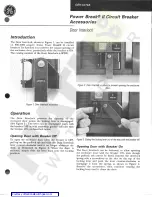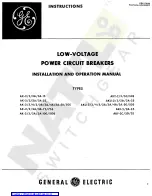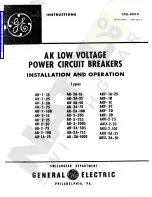
Effective 8/13/99
Page 29
I.L. 70C1037H02
NOTICE
THE PROVISION FOR ZONE INTERLOCKING IS
STANDARD ON MAGNUM CIRCUIT BREAKERS WITH
DIGITRIP 520 FAMILY TRIP UNITS FOR SHORT TIME
AND GROUND FAULT FUNCTIONS. THE APPROPRI-
ATE JUMPER TO TERMINAL B8 AND B9 MUST BE
ADDED ON THE BREAKER IF ZONE INTERLOCKING
IS NOT DESIRED OR IF FIELD TESTING IS DESIRED.
APPENDIX A Zone Interlocking Examples
CASE 1: There is no Zone Selective Interlocking.
(Standard time delay coordination is used.)
Assume that a ground fault of 2000 Amperes occurs and
refer to Figure A.1.
Fault at location 3
The branch breaker will trip, clearing the fault in 0.1
seconds.
Fault at location 2
The feeder breaker will trip, clearing the fault in 0.3
seconds.
Fault at location 1
The main breaker will trip, clearing the fault in 0.5 sec-
onds.
CASE 2: There is Zone Selective Interlocking.
Assume a ground fault of 2000 Amperes occurs and refer
to Figure A.1.
Fault at location 3
The branch breaker trip unit will initiate the trip in
0.045 seconds to clear the fault and the branch will send
a restraint signal to the feeder trip unit; the feeder will
send a restraint interlocking signal to Z1.
Main and feeder trip units will begin to time out and, in the
event that the branch breaker does not clear the fault, the
feeder breaker will clear the fault in 0.3 seconds (as
above). Similarly, in the event that the feeder breaker
does not clear the fault, the main breaker will clear the
fault in 0.5 seconds (as above).
Fault at location 2
The feeder breaker trip unit will initiate the trip in
0.045 seconds to clear the fault and will send an interlock-
ing signal to the main trip unit. The main trip unit will begin
to time out and, in the event that the feeder breaker Z2
does not clear the fault, the main breaker will clear the
fault in 0.5 seconds (as above).
Fault at location 1
There are no interlocking signals. The main breaker trip
unit will initiate the trip in 0.045 seconds.
Figure A.2 presents a Zone Selective Interlocking connec-
tion diagram for a system with two main breakers from
incoming sources and a bus tie breaker. Note that the
blocking diode D1 is needed so that the feeder breakers
can send interlocking signals to both the main and the tie
breakers and prevent the tie breaker from sending an
interlocking signal to itself.



































